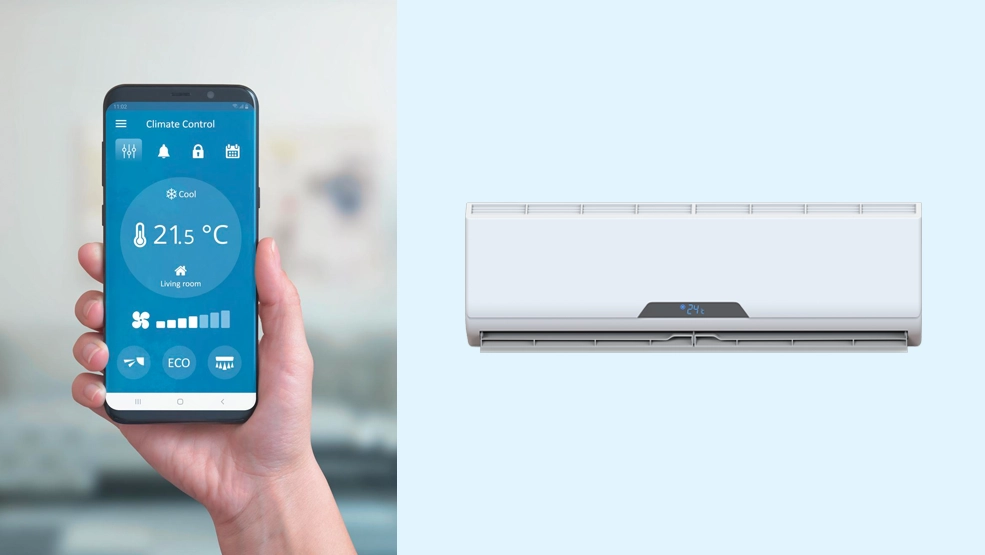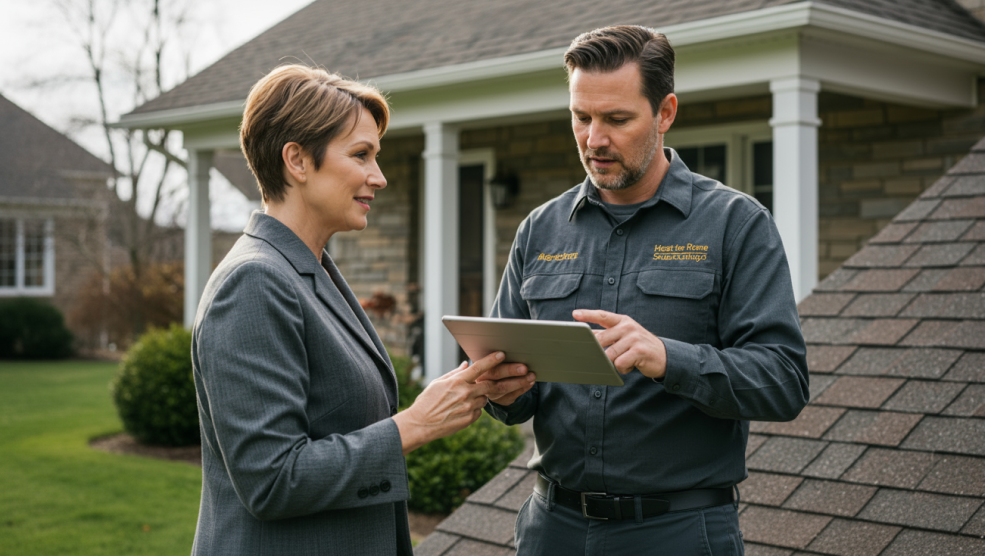Imagine coming home after a long day, sitting down on your comfortable couch, and taking a deep breath of the cool, refreshing air. You smile to yourself, knowing that your smart home system has already taken care of everything, from turning on the lights to adjusting the thermostat.
But that’s not all! With the smart HVAC system in place, you don’t have to worry about humidity levels or about energy waste. Your smart home system weaves its spell and seamlessly integrates with your HVAC system, establishing centralized control and unparalleled convenience.
In this blog, we’ll take you on a journey into the world of smart home integration with HVAC systems, where technology meets your needs effortlessly and enhances both comfort and efficiency in your daily life. Let’s get started.
How does smart home integration work in HVAC systems?
Smart home integration of HVAC systems works through a combination of advanced technology and interconnected devices. The central component of this integration is the smart thermostat, which serves as the brain of the HVAC system. Equipped with sensors and Wi-Fi capabilities, the smart thermostat communicates with other smart devices and the HVAC unit itself.
The process begins with the smart thermostat gathering data from its sensors and external sources, such as weather forecasts. It then analyzes this information to understand your heating and cooling needs, taking into account factors like occupancy patterns and personal preferences.
Based on this data, the thermostat makes real-time adjustments to the HVAC system’s settings. With the power of the Internet of Things (IoT), the smart thermostat can also receive commands and data from your smartphone, voice-controlled assistants, or other smart home devices. This enables you to remotely control your HVAC system and customize its operation according to your needs, even when you’re away from home.
What are the different ways to integrate smart home technology with HVAC systems?
Smart Thermostats
Smart thermostats have revolutionized the realm of home heating and cooling, replacing traditional thermostats with intelligent devices that offer a myriad of advanced features. Among the key advantages of smart thermostats is their remote control capability. With the convenience of smartphone apps or web interfaces, homeowners can effortlessly fine-tune the temperature and manage their HVAC system from any location. Whether one is at work, on vacation, or simply unwinding on the couch, they possess absolute authority over their home’s climate, ensuring ultimate comfort and energy efficiency.
Another important feature of smart thermostats is programmable schedules. These devices allow users to create customized smart heating and cooling schedules based on their daily routines. You can set different temperature preferences for different times of the day or week, optimizing energy consumption by avoiding unnecessary heating or cooling when no one is at home— not only enhancing comfort but also helping reduce energy bills.
Smart thermostats also provide valuable insights into energy usage. They can generate detailed reports on how much energy your HVAC system consumes and offer suggestions on how to save energy. By understanding your energy consumption patterns, you can make informed decisions about adjusting settings or habits to achieve greater energy efficiency, benefiting both the environment and your wallet.
Zoning Systems
Zoning systems offer a highly effective solution for maximizing comfort and energy efficiency in larger homes or those with varying temperature needs in different areas. By dividing the home into distinct zones, each equipped with its own thermostat, homeowners can set specific temperature preferences for individual rooms. This level of customization ensures that occupants can enjoy their desired comfort levels in the spaces they use most frequently.
Zoning systems are particularly useful when different areas of the house have varying heating and cooling requirements. For instance, you might prefer a cooler temperature in your bedroom at night while keeping the living room warmer during the day. By controlling the temperature in each zone separately, you can avoid wasting energy on conditioning unoccupied or less frequently used rooms.
The energy-saving potential of zoning systems is significant. Since the HVAC system only needs to heat or cool specific zones at any given time, it can operate more efficiently, leading to reduced energy consumption and lower utility bills. Overall, zoning systems offer a practical and effective way to enhance both comfort and energy efficiency in your home.
Machine Learning Algorithms
Machine learning algorithms have brought a new level of intelligence to smart thermostats. These algorithms enable the thermostat to learn from your interactions and behavior patterns, continuously improving its performance to meet your comfort needs more effectively. By observing your temperature adjustments, occupancy patterns, and schedule changes, the smart thermostat can develop a better understanding of your preferences and daily routine.
With this information, the smart thermostat can autonomously adjust the HVAC system without requiring constant manual input. It can predict when you’ll be home, anticipate temperature changes based on past behavior, and create a more comfortable environment proactively. As time goes on, the machine learning capabilities become more refined, resulting in a truly personalized and efficient smart heating and cooling experience.
Voice Control Integration
Voice control integration adds an extra layer of convenience and hands-free operation to smart thermostats and HVAC systems. By integrating with popular voice assistants like Amazon Alexa or Google Assistant, homeowners can control their HVAC settings using simple voice commands.
Voice control allows you to change the temperature, adjust settings, or even inquire about the current status of the HVAC system without having to physically interact with the thermostat or pull out your smartphone. This hands-free functionality is especially useful when your hands are occupied or you’re in another room and want to adjust the temperature without leaving what you’re doing.
Additionally, voice control integration often forms part of a broader smart home ecosystem, allowing you to control other connected devices through the same voice assistant. This seamless integration enhances the overall smart home experience, enabling you to manage multiple devices with just your voice.
Top 3 of the most popular smart home devices for HVAC control
1. Nest Learning Thermostat
The Nest Learning Thermostat is a top-tier smart thermostat that has gained widespread popularity due to its sleek and modern design, user-friendly interface, and integrattion with the Google Home ecosystem. One of its standout features is its ability to learn from your daily habits and temperature preferences. Using advanced machine learning algorithms, the Nest Learning Thermostat observes your manual temperature adjustments and interactions with the device over time. Based on this data, it intelligently creates a customized smart heating and cooling schedule that aligns with your routine.
The learning capabilities of the Nest Learning Thermostat ensure that your home is optimally comfortable when you’re present while also maximizing energy savings when you’re away or asleep. Conversely, when you return home or wake up, it readjusts the temperature to your preferred settings, providing a comfortable living environment.
2. Ecobee Smart Thermostat
The Ecobee Smart Thermostat is a highly regarded smart home device that goes beyond traditional temperature control. Its standout feature is the inclusion of room sensors, which sets it apart from many other smart thermostats. These room sensors are strategically placed in different areas of your home to monitor temperature variations in various rooms. By considering the data from these sensors, the Ecobee Smart Thermostat can adjust the HVAC system to maintain a more balanced and consistent temperature throughout the house.
The room sensors offer several advantages, including the ability to eliminate hot or cold spots, ensuring that all occupants experience enhanced comfort. Furthermore, the Ecobee Smart Thermostat utilizes the data from these sensors to implement its Smart Home/Away feature. This feature detects occupancy in different zones and adjusts the temperature accordingly, reducing energy consumption by only conditioning the occupied areas.
3. Honeywell Home T9 Smart Thermostat
The Honeywell Home T9 Smart Thermostat is a feature-rich device designed to offer precise temperature control and energy efficiency. One of its key features is geofencing, which sets it apart from other smart thermostats. Geofencing technology uses the location of your smartphone to detect when you’re leaving or approaching your home. When you leave the designated geofence area, the Honeywell Home T9 Smart Thermostat automatically enters an energy-saving mode, adjusting the temperature to save energy until you return.
Geofencing provides significant energy savings by preventing unnecessary heating or cooling when the house is unoccupied. As you approach your home, the thermostat detects your return and readjusts the temperature to your preferred comfort settings, ensuring that you step into a comfortable environment.
How can smart home integration help you save money on your energy bills?
Smart home integration can significantly reduce energy wastage and, consequently, lower your energy bills. The intelligent scheduling and optimization features of smart thermostats ensure that your HVAC system operates efficiently, only using energy when necessary. By learning your preferences and occupancy patterns, the smart thermostat can pre-cool or pre-heat your home, avoiding energy spikes during peak hours.
Additionally, the ability to remotely control your HVAC system through your smartphone allows you to make real-time adjustments when unexpected changes in your schedule occur. This way, you can prevent unnecessary heating or cooling, resulting in additional cost savings.
How can smart home integration improve your comfort levels?
Smart home integration enables the creation of a personalized and comfortable indoor environment tailored to your preferences. With the ability to set custom schedules and remotely adjust settings, you can ensure your home is always at the perfect temperature.
Additionally, by implementing zoning systems, different areas of your home can have individual temperature settings, accommodating the preferences of each occupant. This targeted control eliminates uncomfortable hot and cold spots, resulting in a consistently pleasant living space for everyone.
In conclusion, smart home integration in HVAC systems revolutionizes our interactions with our homes. With seamless connectivity and intelligent control, these systems offer heightened comfort, improved energy efficiency, and substantial cost savings. Embrace the power of smart technology and transform your living space into a haven of comfort and convenience.



